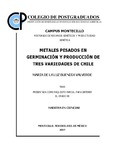| dc.description.abstract | Se evaluaron de forma independiente, los efectos de los metales cadmio (Cd), talio (Tl) y vanadio (V) a tres concentraciones, 0, 25 y 50 M, en indicadores de germinación y crecimiento inicial en tres variedades de chile: Jalapeño, Poblano y Serrano. Las semillas fueron tratadas durante 15 días, y en intervalos de 24 h se cuantificó el número de semillas germinadas para la obtención del porcentaje de germinación (PG). Al final de este periodo, se determinó el porcentaje relativo de germinación (PRG), las longitudes de vástagos (LV) y raíces (LR), el crecimiento relativo de radícula (CRR), el índice de germinación (IG) y el coeficiente de velocidad de germinación (CVG). El PG y el PRG no fueron afectados por los tratamientos. Los principales efectos de los factores de estudio se observaron en indicadores relacionados con el crecimiento inicial. La tolerancia de las variedades de chile evaluadas a los metales en estudio, en orden decreciente es: Jalapeño > Poblano > Serrano. El Tl mostró alta fitotoxicidad en la variedad Serrano; contrariamente, este elemento incrementó la LV en las variedades Jalapeño y Poblano. El Cd estimuló la LV de chile Poblano, en tanto que el V estimuló el CVG en chile Jalapeño, y la LV del chile Poblano. Se concluye que el Cd, Tl y V producen efectos diferenciales, mismos que son dependientes de factores como la variedad de chile probada, la concentración del metal evaluado y la fase de desarrollo (germinación o crecimiento inicial). En un segundo experimento se evaluaron también los efectos, de manera independiente los efectos de estos metales adicionados a la solución nutritiva en diferentes concentraciones (Cd 0, 5 y 10 M; Tl 0, 0.0055 y 0.0110 M; V 0, 0.75 y 1.50 M) durante el ciclo productivo en componentes del rendimiento y concentración foliar de N, P y K de las tres variedades. El Cd redujo el número de frutos por planta, el rendimiento y la longitud de fruto en la variedad Jalapeño; asimismo la dosis baja de Cd (5 M) incrementó de manera significativa la concentración foliar de K en las variedades Poblano; mientras que redujo las de P en las variedades Jalapeño y Serrano. La dosis baja de Cd (5 M) redujo de manera significativa la longitud de frutos de la variedad Serrano. En la variedad Poblano, el Tl estimuló el rendimiento, e incrementó la longitud y el ancho del fruto, así como la concentración foliar de N. En la variedad Serrano, el Tl redujo el rendimiento con la dosis baja (0.0055 M); mientras que con ambas concentraciones evaluadas redujo la longitud de fruto. En la variedad Jalapeño, la dosis baja de Tl redujo significativamente la concentración foliar de K. En la variedad Poblano, el V incrementó el número de frutos por planta, rendimiento, longitud y ancho del fruto, y la concentración foliar de N; con la dosis baja de V aumentó también la concentración foliar de K en esta variedad. En la variedad Jalapeño, el V redujo rendimiento y concentración de N en hojas; la dosis baja de V evaluada redujo también de manera significativa el número de frutos por planta. _______________ HEAVY METALS IN GERMINATION AND PRODUCTION OF THREE VARIETIES OF PEPPERS. ABSTRACT: The effects of cadmium (Cd), thallium (Tl) and vanadium (V) metals at three concentrations, 0, 25 and 50 M, were evaluated independently in germination and initial growth indicators in three pepper varieties: Jalapeño, Poblano and Serrano. The seeds were treated for 15 days, and at 24 h intervals the number of germinated seeds was quantified to obtain the percentage of germination (PG). At the end of this period, the relative germination percentage (PRG), stem length (LV) and root length (LR), relative radicle growth (CRR), germination index (GI) and coefficient of Germination rate (CVG). PG and PRG were not affected by treatments. The main effects of the study factors were observed in indicators related to initial growth. The tolerance of the varieties of pepper evaluated to the metals studied, in decreasing order was: Jalapeño> Poblano> Serrano. Tl showed high phytotoxicity in the Serrano variety; In contrast, this element increased LV in Jalapeño and Poblano varieties. The Cd stimulated the LV of Poblano variety, while the V stimulated the CVG in Jalapeño variety, and the LV of the Poblano variety It is concluded that Cd, Tl and V produce differential effects, which are dependent on factors such as the variety tested, the concentration of the evaluated metal and the development phase (germination or initial growth). In a second experiment, we evaluated the effects of these metals added to the nutrient solution in different concentrations (Cd 0, 5 and 10 M, Tl 0, 0.0055 and 0.0110 M, V 0, 0.75 and 1.50 M) during the productive cycle in components of the yield and foliar concentration of N, P and K of the three varieties. The Cd reduced the number of fruits per plant, yield and length of fruit in the variety Jalapeño. The low dose of Cd (5 M) significantly increased the foliar concentration of K in the Poblano varieties, while reducing P in Jalapeño and Serrano varieties. The low dose of Cd (5 M) significantly reduced the fruit length of the Serrano variety. In the Poblano variety, Tl stimulated yield, increased fruit length and width, and foliar N concentration. In the Serrano variety, Tl reduced yield at low dose (0.0055 M), while with both evaluated concentrations Tl reduced fruit length. In the Jalapeño variety, the low dose of Tl significantly reduced the foliar concentration of K. In the Poblano variety, the V increased the number of fruits per plant, yield, length and width of the fruit, and the foliar concentration of N; with the low dose of V also increased the foliar concentration of K in this variety. In the Jalapeño variety, the V reduced yield and concentration of N in leave, while the low dose of V evaluated also significantly reduced the number of fruits per plant. | es_MX |


